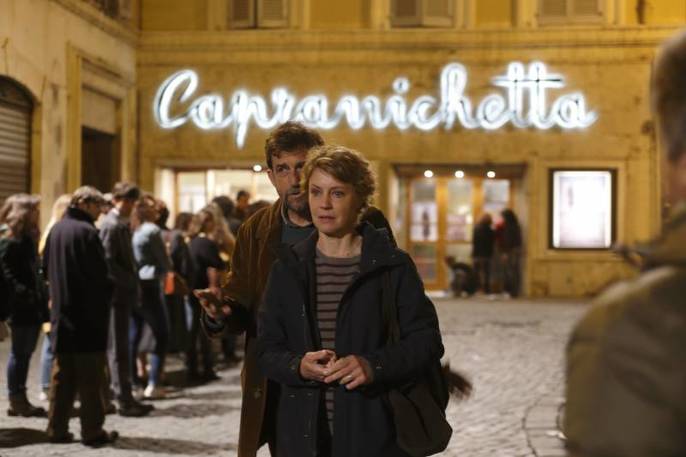


“Why do I keep on repeating the same things? It has been years; everybody thinks that I am capable of understanding what is going on, that I’m able to interpret reality, but I don’t understand anything anymore.”
When asked by the press about her idea of cinema, Margherita (Margherita Buy [2]), the socially committed filmmaker and protagonist of the story, responds: “blunt, raw, sincere, and disenchanted.”
The intimate private drama facing Margherita and her brother, Giovanni (played by Moretti himself), is also a meta-cinematographic reflection of Nanni Morett [3]i who is a socially active politician. Moretti prides himself on his ability to understand contemporary reality, and he captures it through the lens of cinema.
The story is strongly autobiographical; Moretti’s mother died while he was shooting the Vatican fantasy Habemus papam – We Have a Pope. Like the character in the movie, Moretti’s mother was a Classical studies professor. Through Margherita’s character, Moretti portrays his alter ego of a decadent restlessness director whose social angle is reduced to a fake and stereotypical staged class struggle, as rhetorical as those banners filled with corny survival messages for the patients of the hospital. Margherita sees these banners every day when she goes to visit her mother, and she wryly comments “those banners are not real and nobody needs them.”
Rhetoric stands out as one of the biggest and most controversial themes of the movie. Margherita’s mother, played by the pitch perfect Giulia Lazzarini (winner of Nastro d’argento and David di Donatello), a Classical studies teacher, beloved by her students, is dying. Dying with her is a whole world of intellectuals who used rhetoric – the classical art of discourse – to improve the capability of writers and speakers to inform and motivate audiences. That civic sense is fading away, and given the economic and political situation of Italy these days it is undeniable that through this film, Moretti is giving us his disillusioned point of view on the state of current affairs.
Of the ancient and dignified rhetoric, only its modern equivalent remains. “Rhetoric bothers me,” says Margherita, again referring to the hospital’s banners.
It appears that all of the characters have some sort of communication issue. Margerita’s daughter has problems with Latin logical analysis and questions the use of Latin in modern times. The protagonist of the movie, the delightful John Turturro (HBO’s The Night Of, The Big Lebowski), never remembers his lines; Buy’s character is a nerve-racking personality who is incapable of communicating with her troupe as well as with the people in her life. The progressive loss of culture and the weaker voice of modern orators are romantically depicted and linked to the slow deterioration of the mother’s mental and physical strength.
The dichotomy between the microcosms of the social situation and the microcosms of the mother’s personal drama is smoothed by metaphorical transitions. The symbolic maze between reality and the philosophical commentary on it is well crafted with the use of an intricate narrative structure. Reality is broken down into three intervals of time: the present, the past, and the surreal in which Margherita’s memories of her past, of present situations, and of vivid dreams collide, bringing to light the inner turmoil of the drama she is living.
It is no wonder why Moretti partnered with best-selling author and screenwriter Francesco Piccolo (Nastro d’argento winner for We Have a Pope and The Human Capital) and the talented Valia Santella, to craft a story with a strong sense of narrative and beautifully written dialogues.
Buy (who already won the David di Donatello and the Nastro d’argento for this role) delivers an impeccable performance, strong and fragile at the same time, and magnificently human in all the shades and nuances of her eclectic character. John Turturro brings to the film all the wit and levity needed to balance the heaviness of the subject and his sketches with the director are perfect comic vignettes showcasing the actors’ chemistry.
Moretti’s character remains a bit shadowed with his imperturbable calm. His character has the appearance of a quiet observer and remains a less constructed character. The easiness with which he leaves his job, not caring for the economic consequences, makes him seem like a peacefully resigned man, aware that the situation cannot really change. He demonstrates the same attitude regarding the inescapable death of his mother. Resignation seems to be the only language the modern man is capable of speaking.
Generally, the characters’ journeys never reach completion; these arcs appear to be snapshot portraits of intense life moments. A stagnant sense of stillness embraces the characters, all of whom mirror the forced immobility of the mother who is, ironically, the only one who cares about life and still has hopes for a better future. Margherita asks, ”What are you thinking mom?” “I’m thinking of tomorrow,” her mother replies with a bright smile, giving the audience one last gleam of hope that to change the present, we must go back and re-examine our past and our culture.
Now playing in New York City >> [4]
About Mia Madre >> [5]
Source URL: http://test.casaitaliananyu.org/magazine/focus/art-culture/article/nanni-moretti-ready-move-american-audience-once-again-mia-madre-0
Links
[1] http://test.casaitaliananyu.org/files/miamadre24221472585169jpg
[2] https://en.wikipedia.org/wiki/Margherita_Buy
[3] https://en.wikipedia.org/wiki/Nanni_Moretti
[4] http://www.musicboxfilms.com/mia-madre-movies-142.php
[5] http://www.imdb.com/title/tt3013610/